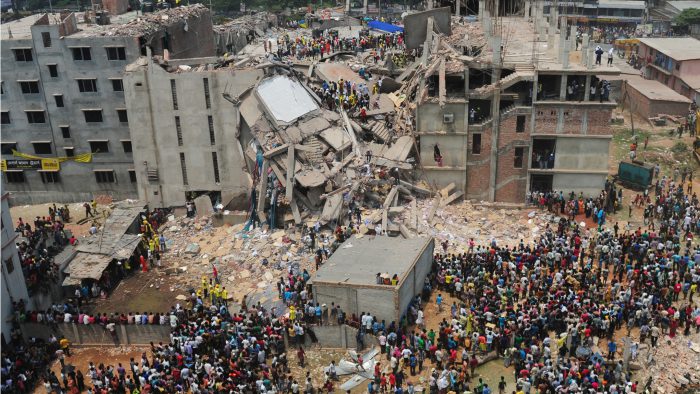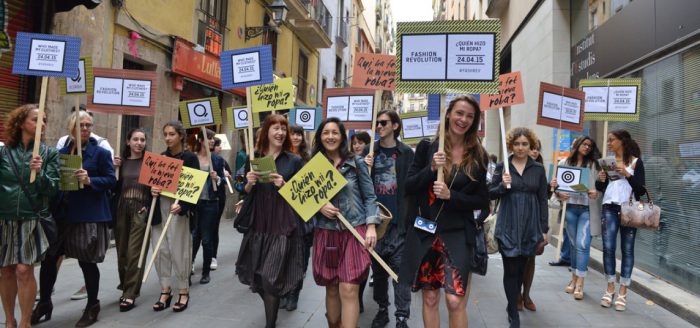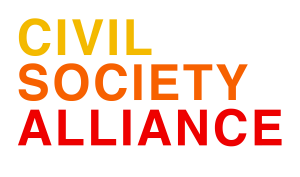Why do we need a Fashion Revolution?
On 24 April 2013, the Rana Plaza building in Bangladesh collapsed. 1,138 people died and another 2,500 were injured, making it the fourth largest industrial disaster in history.
That’s when Fashion Revolution was born.
There were five garment factories in Rana Plaza all manufacturing clothing for big global brands. The victims were mostly young women.

via rijans Flickr CC
We believe that 1,138 is too many people to lose from the planet in one building, on one terrible day to not stand up and demand change.
Since then, people from all over the world have come together to use the power of fashion to change the world.
Fashion Revolution is now a global movement of people like you.
Have you ever wondered who made your clothes? How much they’re paid, and what their lives are like?
Our clothes have gone on a long journey before they hit store shelves, passing through the hands of cotton farmers, spinners, weavers, dyers, sewers and others. Approximately 75 million people work to make our clothes. 80% of them are women between the ages of 18 and 35.
However, the majority of the people who makes clothes for the global market live in poverty, unable to afford life’s basic necessities. Many are subject to exploitation; verbal and physical abuse, working in unsafe and dirty conditions, with very little pay.
Today, both people and the environment suffer as a result of the way fashion is made, sourced and consumed.
This needs to change.
At the moment, most of the world lives in a capitalist economy. This means companies must increase sales growth and make profits in order to succeed — but crucially, not at the expense of peoples’ working conditions, health, livelihoods, dignity and creativity and not at the expense of our natural environment.
Whether you are someone who buys and wears fashion (that’s pretty much everyone) or you work in the industry along the supply chain somewhere or if you’re a policymaker who can have an impact on legal requirements, you are accountable for the impact fashion has on people’s lives and on nature.
What needs to change:
The Model, Material and Mindset
In order to achieve change three key things need to be addressed, and we borrow from a brilliant framework developed by researchers Rebecca Earley and Kate Goldsworthy to explain.
1. MODEL — The business of fashion
The way fashion is produced and consumed has been dramatically scaled and sped up in the last 20-30 years and so too we have seen more frequent and deadlier factory disasters. For the past decade, apparel companies have seen rising costs, driven by rising labour, raw material and energy prices. Yet despite the higher cost of making clothes, the price we pay for our clothing is cheaper than ever before. This is system isn’t working.
Fashion Revolution believes that the whole fashion industry needs a radical paradigm shift and that the way that we produce and consume clothes needs to be transformed. This means business models will need to change and a multiplicity of solutions will be required.
2. MATERIAL — People & planet
Human rights abuses and environmental degradation remains rife. The harsh reality is that basic health and safety measures do not exist for many of the people working in fashion’s supply chains. The legal minimum wage in most garment-producing countries is rarely enough for workers to live on.
150 billion items of clothing are delivered out of factories annually yet Americans alone throw away approximately 14 million tonnes of garments each year, that’s over 36 kg per person. According to the Environmental Protection Agency (EPA), 84% of unwanted clothes in the United States in 2012 went into either a landfill or an incinerator.
Meanwhile, artisanal and heritage craft industries are being eroded, due in large part to mass manufacturing and partly as a result of second-hand clothes flooding local markets. We risk losing ancient techniques that have been passed down through generations in communities around the world.
Our clothes have a devastating environmental impact too. The chemicals used to grow, dye, launder and treat our clothes end up polluting rivers. A huge amount of water is used to produce garments through growing cotton and through wet processing, such as dyeing and laundering. And finally, clothing accounts for around 3% of global production of CO2 emissions, according to The Carbon Trust.
3. MINDSET — Shifting the way we think about fashion
The way we consume clothing has changed a lot over the past 20-30 years too. We buy more clothes than we used to and spend less on them. A century ago, we spent more than half our money on food and clothes, today we spend less than a fifth. As a society we purchase 400% more clothing today than we did just 20 years ago. Every time we buy something that costs less than we think it should, we are implicit in the impacts of that transaction.
We need to break our addiction to the need for speed and volume. We need to realise the true cost of our cheap bargains. Ultimately, we need to buy less, buy better and keep asking questions about the realities behind what we’re purchasing. We need to love the clothes we already own more and work harder to make them last.
However, mindsets are beginning to shift. This is evidenced by the large number of people who have been involved with Fashion Revolution over the past four years. Read more about our impact so far.
The State of Fashion 2017 report from McKinsey and Business of Fashion explains:
“If 2016 was a year of opposing forces clashing, the push for sustainability was one common thread across the industry. Sustainability is becoming an important new driver of consumers’ purchasing decisions. In emerging markets, for example, more than 65 percent of consumers actively seek out sustainable fashion.”

Fashion Revolution is a global movement calling for a fairer, safer, cleaner, more transparent fashion industry.
We are campaigning for a more accountable industry, where dignity of toil and a safe environment are a standard and not an exception.
As citizens and consumers — our questions, our voices, our shopping habits can have the power to help change things for the better. We are the driver of trends. Every time we buy something, we’re voting with our wallet. When we speak, brands and governments listen.
We believe the first step towards positive change is greater transparency.
Fashion Revolution believes in a fashion industry that values people, planet, creativity and profit in equal measure and that positive change starts with transparency, traceability and openness.
It is impossible for us to make sure human rights are respected and that environmental practices are sound without knowing where our products are made, who is making them and under what conditions. This is what we are asking brands and retailers to publicly disclose.
Transparency alone does not represent the bigger systemic change we would like to see for the fashion industry — but it helps us get there. Transparency helps to reveal the structures in place so we can better understand how to change them. Transparency shines a light on issues often kept in the dark.
We believe that more transparency will lead to greater accountability, which eventually will lead to a change in the way business is done. It is an important first step towards positive change.
Find out more about why transparency matters.
We deserve to know who makes our clothes and under what conditions.
This is why, during Fashion Revolution Week, we encourage as many people as possible to ask #whomademyclothes?
It starts with you! Ask yourself: “Who made my clothes?” And then most importantly, ask the brands and retailers you buy from.
Some brands won’t answer at all. Some might tell you where your clothes were made but not who made them. Some will direct you to their Corporate Social responsibility Policy. That’s not good enough. Keeping asking until you get right down to the factory where your garment was made or even the name of the person who made it.
If a brand doesn’t respond, keep asking. Our power is in persistence. The more people who keep asking #whomademyclothes, the more brands will listen.
Find out more about how to get involved in Fashion Revolution.

Calling all farmers, factory workers, artisans and makers show us that #imadeyourclothes
Whether you are a cotton farmer, a dyer, a spinner, a weaver, a garment worker, a co-operative or a factory, an artisan or someone who sews or knits, We want to see your faces and hear your stories. Tell us #imadeyourclothes
We want to see an increasing number of brands show us who produces their clothes using the hashtag #imadeyourclothes
Transparency is a way to bring wider recognition to the many skilled workers and artisans within the fashion supply chain. This, in turn, will help ensure their work is properly valued and justly remunerated in the future.
Discover more ways for to get involved with #imadeyourclothes










